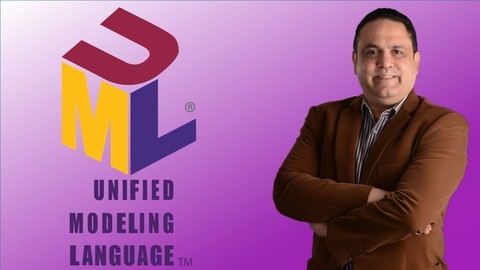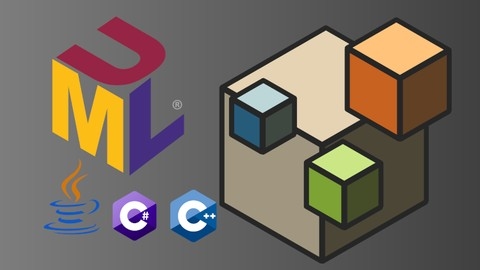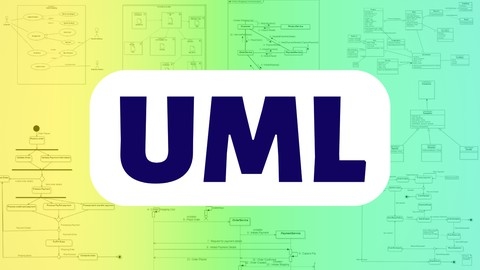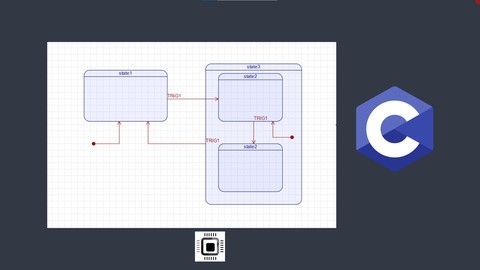The Unified Modeling Language (UML) is a powerful visual language used for specifying, visualizing, constructing, and documenting the artifacts of software systems.
It’s a cornerstone of object-oriented design and analysis, allowing developers to model complex systems in a clear and concise manner.
By learning UML, you can improve your ability to design robust, maintainable software, communicate your ideas effectively with colleagues, and ultimately build better software.
You’ve likely landed on this page because you’re searching for the best UML course on Udemy to elevate your software development skills.
Sifting through the vast array of options can be overwhelming, leaving you unsure which course will truly provide the knowledge and practical experience you need.
You’re looking for a course that balances theory with hands-on exercises, taught by an experienced instructor who can guide you through the intricacies of UML.
Look no further!
Our top recommendation for the best overall UML course on Udemy is UML and Object-Oriented Design Foundations.
This course offers a comprehensive introduction to object-oriented design principles and the practical application of UML.
It covers a wide range of UML diagrams, provides clear explanations, and includes hands-on exercises to solidify your understanding.
This is just one of the many excellent UML courses available on Udemy.
We’ve curated a list of top-rated options, each catering to specific needs and learning styles.
So, keep reading to discover the perfect UML course to help you master this essential skill and take your software development expertise to the next level.
UML and Object-Oriented Design Foundations
This course provides a comprehensive foundation in object-oriented design, focusing on the use of the Unified Modeling Language (UML).
You’ll gain a solid understanding of how UML diagrams can help visualize and design complex software systems.
The course starts with a valuable exploration of software development methodologies, comparing the Waterfall and Agile approaches.
This comparative analysis helps you understand the strengths and weaknesses of each methodology and consider which best suits your project needs.
The core concepts of object-oriented programming, such as objects, classes, abstraction, encapsulation, inheritance, and polymorphism, are explained clearly.
You’ll develop a strong grasp of these fundamental concepts and how they contribute to the structure and functionality of object-oriented systems.
Moving beyond theory, the course delves into object-oriented analysis and design.
You’ll learn to use UML to model your systems, creating various diagrams including use case, class, sequence, activity, and statechart diagrams.
This hands-on approach allows you to apply your understanding to real-world scenarios.
The course also includes a practical case study where you design a note-taking app from scratch.
This experience solidifies your understanding of object-oriented design principles by walking you through the entire design process.
You’ll collect requirements, map them to user stories, create UML diagrams, and model state transitions.
This practical approach is a significant advantage as it provides a concrete example of how the concepts you learn can be applied in real-world projects.
UML Class Diagrams for Programmers
This course equips you with a comprehensive understanding of UML class diagrams, a cornerstone skill for any programmer.
You’ll delve into the fundamental concepts, mastering the art of creating class diagrams, the intricate relationships between classes, and their practical application within real-world projects.
The curriculum unfolds with an introduction to UML diagrams before diving deep into the specifics of class diagrams.
You’ll navigate through basic concepts like classes, attributes, and operations, progressing to more advanced areas like relationships, interfaces, and enumerations.
The course cleverly utilizes a practical example, an online store, to illustrate how you can effectively employ UML diagrams in designing and documenting your software.
You’ll leave with a reference guide meticulously summarizing the crucial concepts, solidifying your understanding.
A unique bonus awaits: coupons for other programming courses, offering you further learning opportunities.
This course isn’t just about knowledge, it’s about building the confidence and skills to excel in your programming endeavors.
UML Fundamentals
This “UML Fundamentals” course offers a comprehensive exploration of the Unified Modeling Language (UML), providing a solid foundation for understanding and applying its various diagram types in software development.
You’ll start by delving into the fundamental building blocks of UML – class diagrams.
This section will equip you with the knowledge of classes, objects, attributes, and operations, along with their essential relationships.
You’ll gain a clear understanding of the distinction between objects and classes and how they are represented within UML diagrams.
The course also introduces you to key concepts like associations, generalizations, and specializations, crucial for building robust models.
Moving beyond class diagrams, you’ll delve into the world of object diagrams, learning how to represent objects and their connections within a system.
You’ll gain an understanding of object state and how to model it using UML.
The course then delves into advanced class diagrams, exploring interfaces, enumerations, and the internal structure of classes, enriching your understanding of complex system modeling.
The course then expands to encompass a wider range of diagrams, including use case diagrams, interaction sequence diagrams, and communication diagrams.
You’ll learn how to effectively model actors, use cases, and interactions within these diagrams, gaining proficiency in visualizing software systems from different perspectives.
You’ll also explore activity diagrams, which help model processes and workflows, learning about actions, control flows, decisions, parallel flows, and swimlanes, key elements for understanding complex system behavior.
Finally, the course concludes with state machine diagrams, which provide a visual representation of an object’s states and transitions.
You’ll also be introduced to component diagrams, representing the components of a software system, and deployment diagrams, which illustrate how a system is deployed on different nodes.
Unified Modeling Language (UML): Complete Guide & Examples
This comprehensive course offers a thorough exploration of Unified Modeling Language (UML), equipping you with the skills to effectively visualize and document software systems.
You’ll master the creation of essential diagrams like Use Case Diagrams, Activity Diagrams, Class Diagrams, and Sequence Diagrams.
These diagrams are not merely static representations; they serve as powerful tools for understanding complex systems, facilitating communication among developers, and guiding software design decisions.
The course thoughtfully begins with a strong foundation in the core principles of UML, emphasizing its vital role in software development.
You’ll gain a firm grasp of Use Cases and their application in defining system functionality.
You’ll then delve into the creation of Use Case Diagrams, encompassing both foundational concepts and advanced notations, all while adhering to established best practices for producing high-quality diagrams.
The curriculum seamlessly transitions to Activity Diagrams, providing you with the ability to model the intricate flow of activities within a system.
You’ll develop a sophisticated understanding of how to construct detailed diagrams that accurately depict diverse paths, decision points, and parallel processes.
The course further delves into Class Diagrams, essential for modeling object-oriented systems.
You’ll acquire a deep understanding of key relationships like dependency, association, aggregation, and composition, and you’ll learn how to effectively represent these relationships within your diagrams.
This comprehensive approach extends to the exploration of Object Diagrams, which offer a snapshot of specific class instances at a particular point in time.
As you progress, the course introduces more complex diagrams, such as Sequence Diagrams.
You’ll learn how to depict the dynamic interactions between objects over time, mastering the representation of messages, activations, and time sequences.
Finally, you’ll explore State Transition Diagrams, gaining expertise in modeling object behavior based on distinct states and triggering events.
Throughout the course, you’ll benefit from the practical application of UMLet, a powerful tool for creating professional-quality diagrams.
Real-world case studies are woven throughout the curriculum, showcasing the practical application of UML in diverse software development scenarios.
This course leaves you well-prepared to not only comprehend the intricacies of UML but also to confidently apply your newfound knowledge in your own software projects.
Advanced Object Oriented Analysis of Hard Problems using UML
This course goes beyond the superficial understanding of UML, delving deep into the cognitive and philosophical foundations of conceptualization.
You’ll start by exploring the cognitive science behind how humans form concepts, examining the crucial role of semantic memory and the power of visual representation in creative thinking.
You’ll then move into the philosophical realm, dissecting the intricacies of concepts through Ogden’s Triangle and exploring various theories like the classical, prototype, and theory theory.
The course examines the intentionality of the mind and the impact of collective intentionality on our understanding of the world.
You’ll learn the complexities of language, including generativity, compositionality, and speech acts, and how they influence communication and the construction of meaning.
The course then dives into the ontological nature of objects, analyzing their properties, relations, and status functions.
You’ll grapple with the definition of facts and truth, including the concept of social facts, and how these concepts inform our understanding of the world.
Armed with this theoretical foundation, you’ll then move into the practical realm of UML.
You’ll learn about classes, instances, associations, generalizations, and packages, mastering the tools to build robust models.
You’ll participate in a hands-on workshop that provides practical experience with applying these concepts to real-world scenarios, utilizing conceptual patterns to simplify complex problems.
The course culminates with a focus on package organization, teaching you how to structure your models for scalability and efficient management of large systems.
Object Oriented Analysis, Design & Programming with UML
You’ll dive into the fundamentals of Object-Oriented Programming (OOP) with a strong emphasis on the Unified Modeling Language (UML).
Right from the start, you’ll learn how to model real-world problems using UML diagrams.
You’ll explore Use Case diagrams to map out user interactions, Class diagrams to define your software’s structure, and Sequence diagrams to visualize interactions between objects.
You’ll gain hands-on experience implementing these designs using popular programming languages like Java, C#, and C++.
The course goes beyond the basics, guiding you through essential OOP concepts like abstraction, encapsulation, inheritance, and polymorphism.
You’ll learn to apply these concepts to create robust software solutions, like building a fully functional game environment complete with player characters, game objects, and collision detection.
The course emphasizes practical application, incorporating interactive exercises and projects that allow you to solidify your understanding and build confidence in your OOP skills.
You’ll learn how to effectively utilize UML for real-world projects, making you a valuable asset in any development team.
The Complete UML Course: Learn to Design UML Diagrams
You’ll gain a deep understanding of UML diagrams, their purpose, and how they work together to create a clear, well-structured system.
The syllabus meticulously outlines the various types of UML diagrams, from fundamental ones like class and sequence diagrams to more advanced concepts like composite structure diagrams and timing diagrams.
You’ll learn how to design these diagrams effectively, avoiding common pitfalls, and will even get practical experience with popular tools used in the industry.
This course is particularly valuable for anyone involved in software development, as it bridges the gap between conceptual design and practical implementation.
The syllabus’s clear organization and step-by-step approach make it accessible for both beginners and experienced professionals seeking to enhance their UML skills.
You’ll acquire a solid foundation in UML, enabling you to collaborate effectively with colleagues, communicate design decisions clearly, and develop software that is both efficient and adaptable.
Embedded System Design using UML State Machines
You’ll start with the fundamentals of finite state machines, exploring both Mealy and Moore machine models.
You’ll learn to create state transition tables and implement these models in real-world examples, like controlling LEDs.
You’ll then move on to mastering the art of UML flat state machines, using tools like Astah UML to design and implement projects.
You’ll explore various state machine types, including simple and composite states, internal activities, transitions, and events.
You’ll engage in hands-on exercises like building a Productivity Timer, understanding event producers, and implementing button debouncing techniques.
The course further delves into the practicalities of implementing state machines in code.
You’ll explore different techniques such as function pointers, nested switch techniques, and the state table approach.
You’ll utilize tools like Microsoft VS Code and PlatformIO for development and test your code on actual hardware.
The course concludes with a deep dive into Hierarchical State Machines (HSMs) and the QP™ framework.
You’ll learn about run-to-completion and explore the QP™ Nano Arduino library.
You’ll even test HSM transition execution sequences using tools like QM.
Throughout the course, you’ll build several exciting projects, including a Clock Alarm, and explore the concept of active objects and orthogonal state patterns.
This course is a strong foundation for anyone wanting to master embedded system design using UML state machines.








